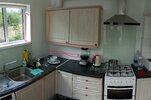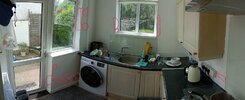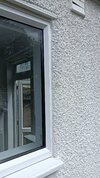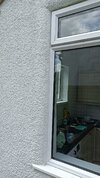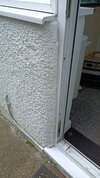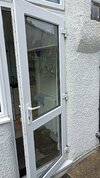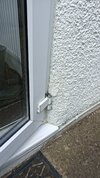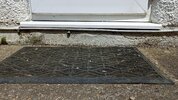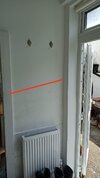- Joined
- 27 Aug 2018
- Messages
- 9
- Reaction score
- 0
- Country

Hi, I’d be really grateful for some advice on how to deal with a penetrating damp problem on my property. It’s a solid brick 1930s semi with what I think was originally a scullery sticking out the back of the kitchen. The walls of this are brick but thinner than those of the rest of the house. I’m getting damp coming through these walls in various places. Quite a lot of this is next to uPVC windows / door but also happening on plain wall (see photos). I originally thought the problem was due to condensation so have had extractors and radiator installed – the damage shown is since new plaster and paint in Oct last year.
The outside has at some point been given a layer of what I think is Spar. I suspect this is probably over the top of the original pebble dash. I can’t see any signs of significant cracking in the spar in the areas affected (although the paint might hide them if they’re there) but I don’t know what condition the pebble dash underneath is in. The brickwork mortar throughout the house is really soft and we’ve found plenty of gaps in it as we’ve done other work – I expect the same is true of the scullery. I’ve recently put sealant along the joint between Spar and window/door frames, but no sign yet that this is making any difference.
The longer term plan is to take this all down as part of an extension so I need a cost-effective solution that keeps it watertight in the meantime. The two options I see at the moment are either (a) to have the spar / pebble dash removed, the walls repointed and a new render coating applied and painted or (b) to clad the walls with uPVC planks to keep the water off (yes I know it’ll probably be ugly!). Either way I might look to add some external insulation.
I’d really value comments on whether these options are likely to solve the problem, are there others I should be considering and any pro’s and con’s I should be thinking about. Should a decent render coat keep a wall like this dry on the inside? Is there a risk that removing the existing spar / pebble dash damage the walls?
Many thanks.
The outside has at some point been given a layer of what I think is Spar. I suspect this is probably over the top of the original pebble dash. I can’t see any signs of significant cracking in the spar in the areas affected (although the paint might hide them if they’re there) but I don’t know what condition the pebble dash underneath is in. The brickwork mortar throughout the house is really soft and we’ve found plenty of gaps in it as we’ve done other work – I expect the same is true of the scullery. I’ve recently put sealant along the joint between Spar and window/door frames, but no sign yet that this is making any difference.
The longer term plan is to take this all down as part of an extension so I need a cost-effective solution that keeps it watertight in the meantime. The two options I see at the moment are either (a) to have the spar / pebble dash removed, the walls repointed and a new render coating applied and painted or (b) to clad the walls with uPVC planks to keep the water off (yes I know it’ll probably be ugly!). Either way I might look to add some external insulation.
I’d really value comments on whether these options are likely to solve the problem, are there others I should be considering and any pro’s and con’s I should be thinking about. Should a decent render coat keep a wall like this dry on the inside? Is there a risk that removing the existing spar / pebble dash damage the walls?
Many thanks.
Attachments
-
 IMG_20240601_120540-Mark.jpg347.7 KB · Views: 33
IMG_20240601_120540-Mark.jpg347.7 KB · Views: 33 -
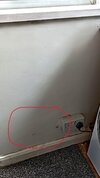 IMG_20240601_120601-mark.jpg233.8 KB · Views: 31
IMG_20240601_120601-mark.jpg233.8 KB · Views: 31 -
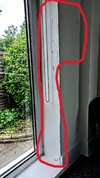 IMG_20240601_120617-mark.jpg285.6 KB · Views: 23
IMG_20240601_120617-mark.jpg285.6 KB · Views: 23 -
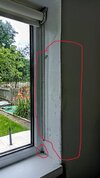 IMG_20240601_120628-Mark.jpg258.7 KB · Views: 27
IMG_20240601_120628-Mark.jpg258.7 KB · Views: 27 -
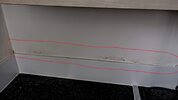 IMG_20240601_120658-Mark.jpg124.4 KB · Views: 30
IMG_20240601_120658-Mark.jpg124.4 KB · Views: 30 -
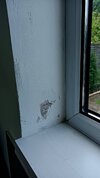 IMG_20240605_123838.jpg181.2 KB · Views: 32
IMG_20240605_123838.jpg181.2 KB · Views: 32 -
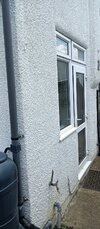 IMG_20240605_124424.jpg399.4 KB · Views: 31
IMG_20240605_124424.jpg399.4 KB · Views: 31 -
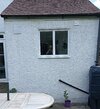 IMG_20240605_124439.jpg682.3 KB · Views: 26
IMG_20240605_124439.jpg682.3 KB · Views: 26 -
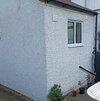 IMG_20240605_124454.jpg795.1 KB · Views: 32
IMG_20240605_124454.jpg795.1 KB · Views: 32

